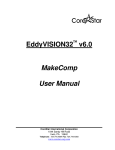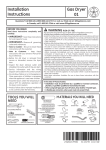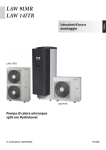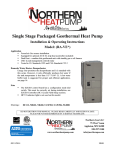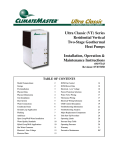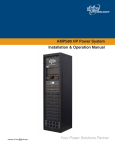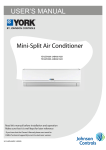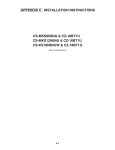Download Electra WNG 80 DCI Installation manual
Transcript
1. ACCESSORIES SUPPLIED WITH THE AIR CONDITIONER 2. LOCATION OF INDOOR AND OUTDOOR UNIT 3. INSTALLATION/SERVICE TOOLS (ONLY FOR R410A PRODUCT) 4. INSTALLATION OF THE INDOOR UNIT 5. CONDENSATE HOSE CONNECTION 6. ELECTRICAL CONNECTION BETWEEN INDOOR AND OUTDOOR UNIT 7. REFRIGERANT TUBING 8. FINAL TASKS I N S TA L L AT I O N I N S T R U C T I O N S FOR DCI SPLIT WALL MOUNTED AIR CONDITIONER 1 ACCESSORIES SUPPLIED WITH THE AIR CONDITIONER Shape Name Qty Used for 2 LOCATION OF INDOOR AND OUTDOOR UNIT Select the location considering the following: INDOOR UNIT Mounting plate 1 Remote control with batteries 1 Remote control bracket 1 Screws washer dowels 4 Wall mounting of the indoor unit Operation of unit Wall mounting of the remote control Wall mounting of indoor unit 1. Choose a location which will provide good air circulation. 2. Do not install the unit near a heat source or where it will be exposed to direct sunlight. 3. The location must allow convenient electrical wiring. drainage and tubing connections as shown in fig 3. 4.The appliance must be positioned so that the plug is accessible. 5 Installation site should provide an easy passage to outdoors. 6. The unit must be mounted on a strong wall that will withstand the generated vibrations. 7. Install the mounting plate as shown in fig 5. 8. Install the remote control bracket as shown in fig 4. Screws dowels Outdoor unit drain connector Mounting pads 2 1 4 Wall mounting of remote control bracket Outdoor unit water drain Padding of outdoor unit bottom support OUTDOOR UNIT 1. The location must allow easy servicing and provide good air circulation as shown in fig 5. 2. The unit may be suspended from a wall by a bracket (Optional) or located in a free standing position on the floor (preferably slightly elevated). 3. If the unit is suspended, ensure that the bracket is firmly connected and the wall is strong enough to withstand vibrations. 4. Unit location should not disturb neighbors with noise or exhaust air stream. 5. Place the mounting pads under the unit legs. Cable ties 4 Securing wires in the indoor and outdoor unit Power input cable (Optional) 1 Connecting indoor unit power Cable terminals 1 Securing of grounding wire in the indoor and outdoor unit Air purifying filter (Optional) 2 Cleaning the air 6. Refer to figure 5 for allowed installation distances. 7. When the unit is installed on a wall, install the drain connector hose and drain plug as shown in fig 1 and fig 2. Fig.1 1.Bottom of outdoor unit 2.Drain connector Fig. 2 Fig. 1 Remote control 3 operation Unit operation Installation manual 1 Users and installers reference Indoor Unit's Accessories Only for One Unit. Fig.2 Drain installation Example 2 950mm 1800mm 80 mm min Fig. 3 50 mm min 50 mm min 2300 mm min To remove 2 100 mm min 1 100 mm min 400 mm min To attach Fig. 4 500 mm min 100 mm min NOTE: Distance between indoor and outdoor units should be 30m. Height difference between indoor and outdoor units should be 15m. No additional charge is required. 1 Fig. 5 Fig.5 1. Mounting pads ( 4) 3 INSTALLATION/SERVICE TOOLS (ONLY FOR R410A PRODUCT) CAUTION New Refrigerant Air Conditioner Installation THIS AIR CONDITIONER ADOPTS THE NEW HFC REFRIGERANT (R410A) WHICH DOES NOT DESTROY OZONE LAYER. R410A refrigerant is apt to be affected by impurities such as water, oxidizing membrane, and oils because the working pressure of R410A refrigerant is approx. 1.6 times of refrigerant R22. Accompanied with the adoption of the new refrigerant, the refrigeration machine oil has also been changed. Therefore, during installation work, be sure that water, dust, former refrigerant, or refrigeration machine oil does not enter into the new type refrigerant R410A air conditioner circuit. To prevent mixing of refrigerant or refrigerating machine oil, the sizes of connecting sections of charging port on main unit and installation tools are different from those used for the conventional refrigerant units. Accordingly, special tools are required for the new refrigerant (R410A) units. For connecting pipes, use new and clean piping materials with high pressure fittings made for R410A only, so that water and/or dust does not enter. Moreover, do not use the existing piping because there are some problems with pressure fittings and possible impurities in existing piping. Changes in the product and components In air conditioners using R410A, in order to prevent any other refrigerant from being accidentally charged, the service port diameter size of the outdoor unit control valve (3 way valve) has been changed. (1/2 UNF 20 threads per inch) In order to increase the pressure resisting strength of the refrigerant piping, flare processing diameter and opposing flare nuts sizes have been changed. (for copper pipes with nominal dimensions 1/2 and 5/8) New tools for R410A New tools for R410A Applicable to R22 model Changes Gauge manifold As the working pressure is high, it is impossible to measure the working pressure using conventional gauges. In order to prevent any other refrigerant from being charged, the port diameters have been changed. Charge hose In order to increase pressure resisting strength, hose materials and port sizes have been changed (to 1/2 UNF 20 threads per inch). When purchasing a charge hose, be sure to confirm the port size. Electronic balance for refrigerant charging As working pressure is high and gasification speed is fast, it is difficult to read the indicated value by means of charging cylinder, as air bubbles occur. Torque wrench (nominal dia. 1/2, 5/8) The size of opposing flare nuts have been increased. Incidentally, a common wrench is used for nominal diameters 1/4 and 3/8. Flare tool (clutch type) By increasing the clamp bar's receiving hole size, strength of spring in the tool has been improved. Gauge for projection adjustment Used when flare is made by using conventional flare tool. Vacuum pump adapter Connected to conventional vacuum pump. It is necessary to use an adapter to prevent vacuum pump oil from flowing back into the charge hose. The charge hose connecting part has two ports -- one for conventional refrigerant (7/16 UNF 20 threads per inch) and one for R410A. If the vacuum pump oil (mineral) mixes with R410A a sludge may occur and damage the equipment. Gas leakage detector Exclusive for HFC refrigerant. Incidentally, the "refrigerant cylinder" comes with the refrigerant designation (R410A) and protector coating in the U.S's ARI specified rose color (ARI color code: PMS 507). Also, the "charge port and packing for refrigerant cylinder" requires 1/2 UNF 20 threads per inch corresponding to the charge hose's port size. 4 INSTALLATION OF THE INDOOR UNIT INSTALLATION OF THE MOUNTING PLATE 1. Figure 9 shows the location of the mounting plate relative to the unit size. Refer to one of the drawings, according to your unit length (marked in square). REMOVAL AND INSTALLATION OF THE 2. Locate the mounting plate as shown on the wall in a horizontal FRONT PANEL position, using a spirit level. 3. Mark the position of the four mounting holes on the wall and drill four holes to accommodate the dowels. 4. Mount the mounting plate on to the wall by the four screws. Ensure screws are tightened properly. 1. Open the front panel. 2. Open the terminal cover. 3. After installation of the wires, replace the terminal cover and close the grille. Fig.6 1. Lift the grille 2. Screw 3. Terminal Fig. 8 1 2 3 Fig. 6 PENETRATION OF WALL FOR TUBING REFRIGERATION TUBE ROUTING 1. There are five possible routes for installing the refrigeration tube as shown. 2. For route (6), cut the bottom notch in the rear. 3. For routes (5) or (7), cut the side notches in the rear and in the front panel. Fig. 7 1. Front 2. Rear 3. Rear outlet 4. Lefthand outlet 5. Lefthand raw outlet 6. Bottom outlet 7. Righthand outlet 1. Mark the location of the hole on either side of the mounting plate as shown. and drill it at a 5 downward angle, as shown. 2. The hole is drilled at an angle, to prevent condensed or rain water from penetrating back into the room. Fig. 9 A. OUTDOOR SIDE B. INDOOR SIDE 1.Drill 70 mm 2.Wall 4 B A 5 1 Fig. 9 Fig 87 Fig. 2 SUSPENDING AND RELEASING THE UNIT FROM THE MOUNTING PLATE 1. Make sure that the refrigerant tubes, electric cables and condensate water hose are well insulated with closed cell rubber based insulating tubes (6mm thickness), are wrapped together with UV stabilized nonadhesive plastic tape, and are passed through the hole in the wall. 2. Hang the indoor unit on the two hooks that are located near the top edge of the mounting plate as shown in fig. 10 and fig. 11. 3. Press the lower part of the indoor unit against the mounting plate until the catches snap into the slots and lock the indoor unit to the mounting plate. 4. Check the installation by pulling the unit towards you. 5 CONDENSATE HOSE CONNECTION 1. Attach the condensate drain hose to the corrugated hose in the rear groove of the indoor unit. 2. Wrap the drain hose together with the refrigerant tubes and electrical cables. 3. Ensure that the condensate drain hose is at all points installed in a downward slope manner. 5. To release the unit from the mounting plate, lift up the unit and then pull the unit towards you, to ensure that the hooks are locked. Fig.10 1.Indoor unit 2.Snap catches 2 1 2 3 Fig. 12 Fig.13 1.Trap 2.U-bend 3.End immersed in water 3.Top hooks 4.Bottom hooks 1 Fig.12 1.Drain hose 2.Clamp 3.Downward slope 4. When installing the drain hose avoid traps and Ubends. The end of the drain hose should not be immersed in water. 3 1 3 2 Fig. 13 Fig.14 1.Electric cable 2.Refrigerant tubing 3.Condensate drain hose 4.UV stabilized nonadhesive plastic tape 4 Fig. 10 5. For a lefthand outlet, lay the drain hose on the bottom of the indoor unit rear groove. Fig. 14 1 2 Fig.11 1.Mounting plate 2.Lower hook 3 4 1 Fig.15 1.Vent 2.Downward drain 3.Water drain hose 2 Fig. 11 6.When the installation location requires long horizontal sections, a vent must be provided at the top of the hose to prevent overflow of the unit drain pan. 1 Fig. 15 3 2 7.Upon completing the installation, test the water drain by pouring at least two liters of water into the unit drain pan. Check that the water drains off. 6 ELECTRICAL CONNECTION BETWEEN INDOOR AND OUTDOOR UNIT Power input cable ELECTRICAL REQUIREMENTS Electrical wiring and connections should be made by qualified electricians and in accordance with local electrical codes and regulation. The air conditioner units must be grounded. The air conditioner unit must be connected to an adequate power outlet from a separate branch circuit protected by a time delay circuit breaker, as specified on unit's nameplate. Voltage should not vary beyond 10% of the rated voltage. 8 8 100 40 Fig. 17a Cable between indoor and outdoor units L 1. Connect the power supply cable to the indoor unit of WNG. 2. To connect the indoor unit to the outdoor unit use the following electrical cables. 8 8 100 40 A Electrical connections: Power input cable: B Fig. 17b 2.5 mm2 3 wires Cable between Indoor and outdoor units: 4 wires 30 m Fig.17 A. OUTDOOR B. INDOOR 2.5 mm 2 3. Prepare the cable ends for the power input and for the cables between outdoor and indoor units as shown in figure 17a and 17b respectively. 4. Connect the cable ends to the terminals of the indoor and outdoor units, as shown in fig. 18. 1 5. Secure the multiple wire power cable with the cable clamps. 3 ESF-PWR COOL ESF-EN HEAT RESET MODE 5/C 4/L N L 2 Fig.16 1. Terminal 2. Cover 3. Cable clamp 4 8 N 4/L 5/C 7 A B 6 Fig. 16 5 NOTES: 1. The wire color code can be selected by the installer. Fig. 18 Fig.18 1. Indoor unit terminal 2. Ground wire. 3. Indoor coil. 4. Power cable in the indoor side. 5. Multiple wire cable. 6. Cable clamp. 7. Outdoor unit wire terminal. 8. Power cable in the outdoor side (only for outdoor unit power supply) A. OUTDOOR B. INDOOR 7 Tightening torques of unions and valve caps: REFRIGERANT TUBING CONNECT THE INDOOR TO THE OUTDOOR UNIT The indoor unit contains a small quantity of nitrogen. Do not unscrew the nuts from the unit until you are ready to connect the tubing. The outdoor unit is supplied with sufficient refrigerant charge (R410A). Refer to outdoor unit nameplate. Fig. 20 NOTE: Use refrigeration R410A type copper tubing only. 2. Use tubing diameter that corresponds to the tubing diameter of the indoor and outdoor units. Note that the liquid and suction tubes have different diameters. (See tube size, torque tightening table.) 3. Place flares nuts on tube ends before preparing them with a flaring tool. Use the flare nuts that are mounted on the supplied outdoor and indoor units. 4. Connect the all ends of the tubing to the indoor and outdoor units. Notice the sign. All ends should correspond one by one. 5. Insulate each tube separately, and their unions, with at least 13 mm thick of insulation. Wrap the refrigerant tubing, drain hose and electric cables together with a vinyl tape (UV protected). 1 2 Caution! When unscrewing the valve caps, do not stand in front of them or the spindles at any time, as the system is under pressure. 3 4 Fig. 19 Fig. 19 1.INDOOR UNIT 2.Liquid tube (small dia.) 3.Suction tube (large dia.) 4.Plugs 5.Flare nuts 6.Tubing between units 7.Suction tube 8.Liquid tube 9.OUTDOOR UNIT 10.Flare nuts 11.Liquid valve (small) 12.Suction valve (larger) TORQUE 30-35 N.M. 50-54 N.M. 75-78 N.M. 80-100 N.M. Fig. 21 1 To prevent crushing, bend tubes using a bending tool. 1. Open the valve cover. TUBE SIZE Liquid line 3/8" Suction line 1/2" Suction line 5/8" Suction line 3/4" Fig. 22 1 2 2 3 3 Fig.20 1.Wrench 2.Torque wrench 3.Union Fig. 21 To prevent refrigerant leakage, coat the flared surface with refrigeration oil Fig. 22 1.Suction valve 2.Service port 3.Liquid valve EVACUATION OF THE REFRIGERATION TUBES AND THE INDOOR UNIT After connecting the unions of the indoor and outdoor units, purge the air from the tubes and indoor unit as follows: 1. Connect the charging hoses with a push pin to the low side of the charging set and the service port of the suction valve. Be sure to connect the end of the charging hose with the push pin to the service port. 2. Connect the center hose of the charging set to a vacuum pump. 3. Turn on the power switch of the vacuum pump, turn off the high side switch and make sure that the needle in the gauge moves from 0 MPa (0cm Hg) to -0.1 MPa (-76cm Hg). Let the pump run for fifteen minutes. 4. Close the valve of the low side of the charging set and turn off the vacuum pump. Note that the needle in the gauge should not move after approximately five minutes. 5. Not any problem for five minutes, turn on the power switch of the vacuum pump and open the valve of the low side of the charging set. 6. Disconnect the charging hose from the vacuum pump and from the service ports of the suction valve. 7. Tighten the service port caps of suction valve. 8. Redo 1 to 7 for other indoor units. 9. Remove the valve caps from all valves, and open them using a hexagonal Allen wrench. 10. Remount valve caps onto all of the valves. 11. Check for gas leaks from all the connecting position. Test with electronic leak detector or with a sponge immersed for soapy water for bubbles. NOTE For additional charge of various tubing lengths, refer to outdoor unit nameplate. Fig. 23 Fig. 23 1. Charging set 2. Vacuum pump 3. OUTDOOR UNIT 4. Service valve 5. Cap 6. Suction valve 7. Service valve* 8. Cap 9. Liquid valve 10. INDOOR UNIT 11. Suction flare connection 12. Liquid flare connection *In some models only ),1$/ 7$6.6 &KHFN DOO YDOYH FDSV DQG HQVXUH WKDW WKH\ KDG WLJKWHQHG SURSHUO\ &ORVH WKH YDOYH FRYHU )LOO JDSV RQ WKH ZDOO EHWZHHQ KROH VLGHV DQG WXELQJ ZLWK VHDOHU $WWDFK ZLULQJ DQG WXELQJ WR WKH ZDOO ZLWK FODPSV ZKHUH QHFHVVDU\ 2SHUDWH WKH XQLW IRU QR OHVV WKDQ PLQXWHV DW KHDWLQJ RU FRROLQJ PRGH ([SODLQ ILOWHU UHPRYDO FOHDQLQJ DQG LQVWDOODWLRQ 2SHUDWH WKH DLU FRQGLWLRQHU WRJHWKHU ZLWK WKH FXVWRPHU DQG H[SODLQ DOO IXQFWLRQV *LYH WKH RSHUDWLQJ DQG LQVWDOODWLRQ PDQXDOV WR WKH FXVWRPHU $QDOOSROHGLVFRQQHFWLRQVZLWFKKDYLQJDFRQWDFWVHSDUDWLRQRIDWOHDVWPPLQDOOSROHVVKRXOGEHFRQQHFWHGLQIL[HGZLULQJ










